Originally published April 1, 2016.
Customers can get a clear picture through non-verbal clues whether food safety practices are followed once the produce is taken to market or delivered to a CSA drop site. Today’s consumers are more aware of food safety risks associated with fresh produce than in years past, so it makes sense for growers to use best practices to mitigate risks. We are going to touch on a few ways you can demonstrate and assure customers that food safety is your priority.
An increasing number of families around the country are including stops at farmers markets or picking up CSA boxes in their weekly routines. Surveys and studies done around the country show that people are making this effort for several reasons. A 2010 telephone survey in Michigan that assessed consumers’ perceptions and behaviors about local foods and farmers markets found that over half of respondents stated they had visited a farmers market in the past year with the most important reasons being food quality, safety from food borne illnesses, and the ability to support local farms.
Below: The display layout, containers, and produce quality tell customers a lot about a grower’s commitment to food safety. Photos courtesy of Linda Naeve.
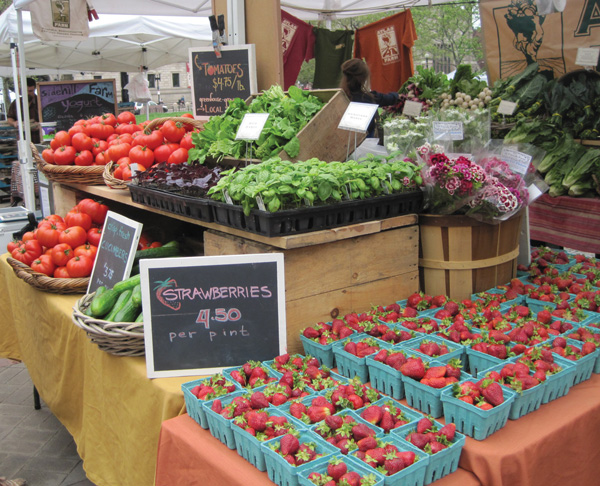
In another study, farmers market customers said they prefer farmers market produce to that from a grocer because they perceived it was superior in quality, was fresher, and a good value for the money. The findings of much of the research about farmers market and CSA customers can be summarized as “It’s locally-grown ... I know that farmer … I can assume it is fresh, healthy and safe.” This assumption, however, is one that farmers market vendors and CSA businesses need to continuously work at to retain consumers’ votes of confidence and trust.
The way in which produce is grown and handled prior to the market or CSA distribution is a matter of trust for the consumer because they do not see what goes on through that process on the farm in getting products ready for them. Good Agricultural Practices (GAPs) guidelines help producers understand and follow good on-farm food safety practices, thereby ensuring the trust placed in them by consumers.
Preparing for market
First, let’s review what should be done before loading for the market. It is important to make sure everything that comes in contact with the produce is cleaned prior to leaving your facilities. This includes the delivery vehicle, display crates and tables. Consumers do perceive cleanliness through their eyes – appearances matter! Access to water may be limited once you are at the market, so make sure items for display and sampling are cleaned and sanitized and then protected during transit (i.e. covered with clean tarp or bags or stored upside down). There is a difference between clean and sanitized. Clean means free of any visible soil whereas a sanitized surface will further reduce the presence of any harmful microorganisms.
Cleaning steps:
Rinse or brush off soil or other residue.
Wash with soap and water (be sure water is from a clean source!)
Rinse to remove any remaining residue and detergent.
Sanitizing procedure:
Apply a fine spray of the sanitizer (at the appropriate concentration).
Allow to air dry; do not wipe or rinse off.
Maintaining product quality during transport and at the market is important for its safety. Always transport it to its destination in a cooled, covered, protected vehicle – the optimum situation is a refrigerated vehicle. Keep cold produce in coolers with the lids always closed and out of direct sunlight until ready for sale. Inexpensive refrigeration thermometers can help you track that product is kept cool.
Below: The way in which you display and package your produce will minimize unnecessary handling and potential contamination by customers.
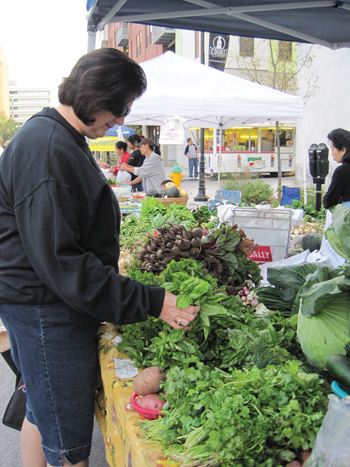
Display and distribution
There are several simple things that farmers can do in their market booth or at a CSA drop site that demonstrate attention to food safety.
Tent or canopy. Vendors and customers always appreciate the shade of a tent for protection from the weather, but the cover serves an additional purpose of covering and protecting produce from dust, birds, and other contaminants. It also shades the produce to help retain its freshness.
Clean tables or table covering. When food items come in direct contact with tables, they should be cleaned and sanitized. A clean, washable or disposable table covering helps keep the food surface clean and presents well at the market. It covers table surfaces that may be stained and/or difficult to clean.
The Look. Uniform containers and boxes enhance a nice display; however, they must be thoroughly cleaned and sanitized. Clear, plastic box liners can be used if baskets and wooden boxes are used for displays (the liner protects the food from the rough textured surfaces which can provide a harbor for bacteria). Be consistent about which produce items go in specific containers. For example, don’t put leafy vegetables and fruits in boxes that have held root crops.
An elevated display on the table not only makes it convenient for the customers to see the product and for you to handle, it also sends a message about your awareness of ways to protect quality and safety of product. Keep extra product in a secure area and avoid placing directly on the ground. Storing behind the table keeps the food in your control and prevents unintentional damage and even intentional sabotage of the foods.
Keep it cool! Some fruits and vegetables lose their quality quickly when set on a display table. It may be a good idea to put just a limited number of items, such as Romaine lettuce or clamshells of raspberries, on the table and continuously restock from a nearby cooler. Some herbs can be held in jars or buckets of drinking-quality water to reduce wilting.
Handling. Think through how and when patrons can select from produce on display. Grape tomatoes, green beans, leaf lettuce and other bulk items can be boxed or bagged and sold by specific volumes or weights to reduce the amount of handling and save time at market. It is hard to know whether all customers have followed good hygiene practices so for produce sold individually it is best to have customers show or tell what they want and bag it for them at point of sale.
CSA farms that distribute their produce like a market (the customer selects the allotted number of items from a bulk crate or box) risk contamination of their products. This risk can be reduced by having a hand-wash station and/or hand sanitizers available and encouraging customers with signs and role modeling to use them prior to selecting their products. Having deli tissues or utensils available, such as tongs, to grab green beans, snap peas or leaf lettuce, also reduces potential contamination.
Handling money and produce at the same time is perceived by consumers as a food safety risk, although there is no published research to support this. But the perception that handling money and then touching food products is unsanitary still exists. Part of marketing is management of perceptions; some vendors have designated staff who only handle produce while others handle the monetary transactions.
Hand-washing and hand sanitizers. This brings us to the importance of hand washing. Vendors should wash their hands frequently. It is a good idea to have more than one person working at each stand so there is more time for hand washing to be a priority. Having a portable hand wash station at your farmers market, booth or CSA drop off site sends a powerful message that you are walking the food safety talk. Hand sanitizers are not a substitute for good hand washing (20 second process using soap and water) but they don’t hurt and can help reduce contamination.
Gloves are also not a substitute for proper hand washing but can be a strategy to use if conditions don’t allow for ease in hand washing as they can avoid bare-hand contact with food. Note the gloves should be used for single types of tasks without interruption – touching a dirty container with a gloved hand moves the contamination to the glove. Plastic disposable gloves are inexpensive and avoid allergies some may have with latex or rubber.
First Impressions. Personal hygiene, appearance, and health of market and CSA workers demonstrates attention to cleanliness and food safety. Clothes worn for farm work can be a source of contamination and do not portray a professional sales image at the market. Hair restraints also demonstrate a conscientious effort to avoid contamination of food and present a cleaner image. Minimize the amount of jewelry worn by sales staff because it, too, can be a source of physical contamination and possibly damage the produce.
The health of workers is also important as humans carry microbial pathogens on their skin, in their hair, on their hands, and in their digestive systems or respiratory tracts. If they are sick with any of symptoms described below, they should stay home and not work around food. A worker should be free of vomiting, stomach upset and diarrhea for at least 24 hours before returning to work. If an employee has been diagnosed with a specific illness, it is advisable to report this to the health department (Hepatitis A, Jaundice, and Norovirus) as these viruses are easily transmitted to others. Even someone with a cold, sore throat and/or fever doesn’t project a healthy image to customers so it is best to assign them alternate duties that do not come into contact with food or food containers. Open cuts or sores on hands also pose a health threat and should be covered with a bandage and then a single-use glove.
Eating and drinking at the market booth does not convey a professional image and there are potential risks to the food. For the safety of the produce and the non-verbal, food safety message it portrays, all food and beverages should be consumed away from the produce display and hands washed thoroughly after eating. It is best to have sufficient help at the market to allow for breaks. If circumstances do not allow for this, closed lid containers can be used discreetly during the market.
Below: This shows two ways a vendor is not demonstrating good food safety practices. Samples should not be cut at the booth but should instead be prepared and cooled prior to the market. Also, workers should not eat at their booths.
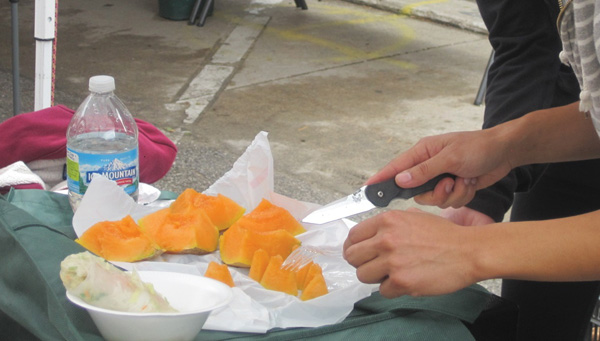
Product samples. Many vendors at the farmers market provide samples to customers to showcase their produce and stimulate sales. There are steps that need to be taken to ensure and demonstrate the safety of those samples.
Prepare the samples at home, not at market, because it may be difficult to find a clean location and hand washing facilities. It may also be difficult to keep knives and cutting boards clean and sanitized.
Before cutting, always clean produce by rinsing under running water that is safe for drinking. For items with textured skins or rinds, some rubbing will help loosen soil.
Store cut samples in a cooler with a freezer gel pack or nestled in ice to maintain it at a temperature no greater than 41°F. Use your refrigerator thermometer to be sure cool temps are maintained throughout the market. Keeping product cool is good for safety but also maintains quality.
Handle samples with freshly washed hands or single-use gloves. When on display, cut samples should be kept covered to prevent contamination from insects and other contaminants.
Avoid potential for multiple handlings by customers with prepared samples that have toothpicks pre-inserted in each piece or samples served in individual serving cups. A utensil such as tongs can also be available for the customers to select a sample without touching with their hands.
Record and keep track of how long samples have been on the display table. To avoid presenting produce that doesn’t look fresh, discard any cut samples that have been sitting out for two hours or, if temperatures are above 90 degrees F, after one hour.
Have a waste basket nearby to discard used sample litter (i.e. plates, toothpicks, cups, and spoons).
Below: Many CSAs have customers select and bag their weekly items. A hand wash station or hand sanitizer available to customers will demonstrate your commitment to food safety.
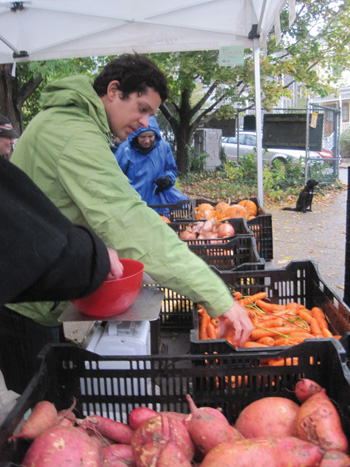
Advice for CSAs
There are almost as many ways in which CSAs package and deliver their product to members (customers) as there are CSAs. Many rely on sturdy, reusable containers – crates, boxes, tubs, or bushel baskets. Regardless of the type of container, it should be cleanable and effectively sanitized before, during and after the delivery season. To avoid product contamination, hard to clean materials such as cardboard and wood can be lined with a new disposable food-safe plastic liner (be sure the material is approved for food contact – not just any garbage bag!).
A lot of effort goes into harvesting, sorting, and packing produce safely to assure a quality product for the customer; it is equally important to provide an appropriate environment during transportation to maintain that quality and safety. Fruits and vegetables held in containers heat up and lose quality rapidly when not stored appropriately, even if it is only for a couple hours. Delivery containers should be kept protected whether that means held indoors, in a cooled vehicle, or under a tent or canopy while waiting to be picked up. When possible, keep highly perishable items, such as leafy greens and berries, in a cooler and put in CSA boxes when customers arrive for pick-up.
In summary, farmers market booths and CSA delivery methods provide many non-verbal cues to customers about your food safety priorities – from product display, containers, worker health and attire, sampling practices, and transit. Attention to detail not only assures a safe product but also strengthens customer confidence and improves their perceptions of trust in you and your products.
Additional training opportunity
Additional information and training is available through an online course titled Farmers Market Food Safety Training developed by extension food safety and horticulture specialists at Iowa State University. It is an excellent training for new and experienced farmers market vendors. The training consists of four online modules designed to provide science-based information on safe food production and handling specific to farmers markets, with a focus on specialty foods and good agricultural practices. For a limited time, this training is free. Participants will receive a Certificate of Completion suitable to display at a vendor booth or market stall after they have watched all four modules. Registration information for the course can be accessed at: http://www.safeproduce.cals.iastate.edu/training/
Sources
Conner, D., K. Colasanti, R. Ross, and S. Smalley. 2010. Locally Grown Foods and Farmers Markets: Consumer Attitudes and Behaviors. Sustainability. 2:742-756.
Wolf, M., A. Spittler, and J. Aheren. 2005. A Profile of Farmers Market Consumers and the Perceived Advantages of Produce Sold at Farmers Markets. Journal of Food Distribution Research 36(1).
Resources
Visit iowafoodsafety.org for food safety issues from farm to fork. It includes several free, downloadable publications such as On-farm Food Safety: Cleaning and Sanitizing Guide and On-farm Food Safety: Guide to Good Agricultural Practices.
Linda Naeve is Extension Program Specialist in Value Added Agriculture and Catherine Strohbehn, PhD, RD, CP-FS, is Extension Food Safety Specialist and Adjunct Professor at Iowa State University, Ames, IA.
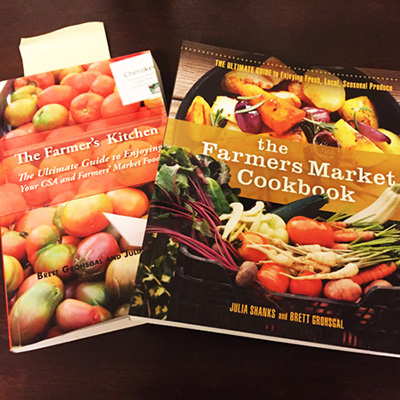
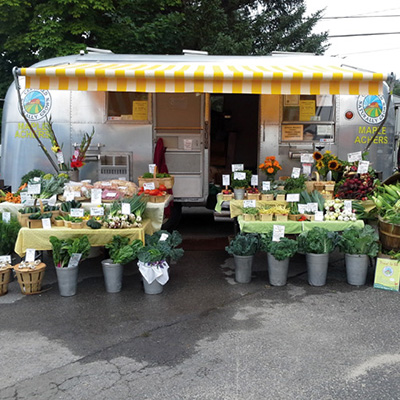
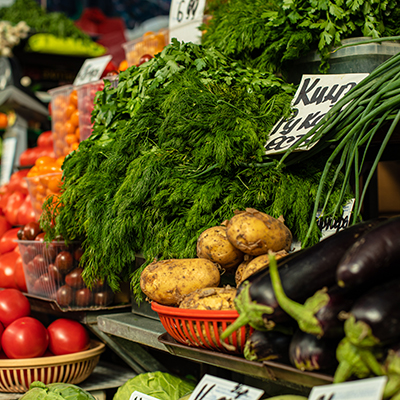

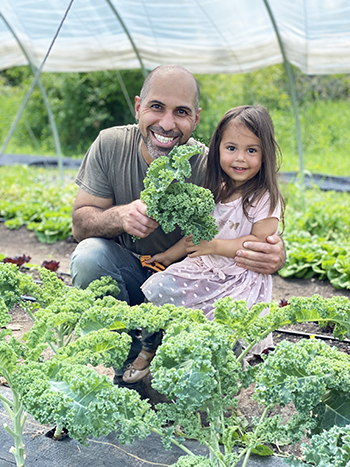

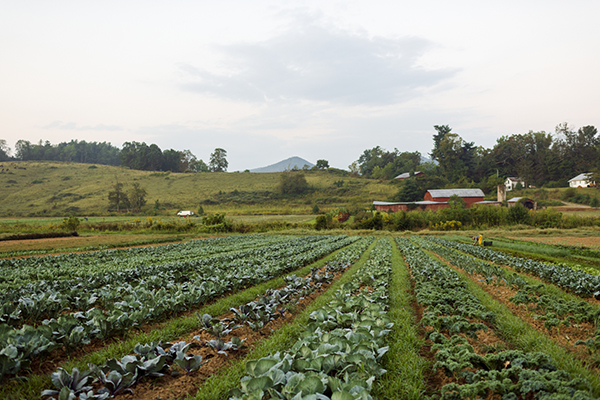 It’s not too late for online/preorder seedling sales, farmers market custom bags, and We Give a Share
It’s not too late for online/preorder seedling sales, farmers market custom bags, and We Give a Share
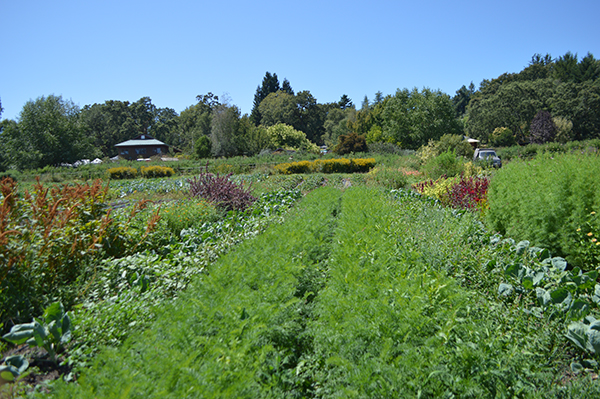 Farmer to Farmer Profile
Farmer to Farmer Profile
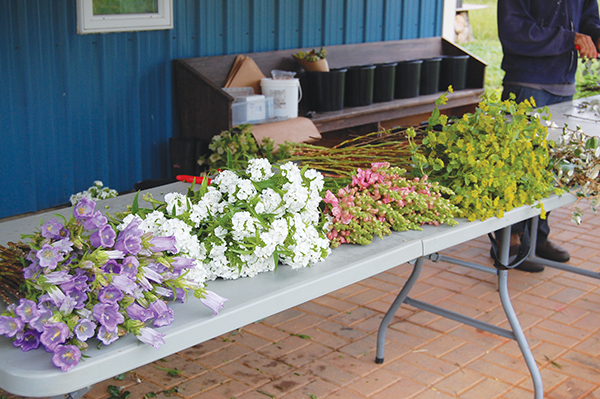 Why is the flower micro-farm best suited to a laser focus on one or two enterprises versus a balance of several? It is because of the long maturity of flower crops and the specific and conflicting demands of different types of flower enterprises. For example, some of the most common ways for farms to sell their flowers are at a farmers market, wholesale, from a flower stand/truck, a CSA, and weddings/events. These outlets can be compared on their need for similar types and quantities of flowers.
Why is the flower micro-farm best suited to a laser focus on one or two enterprises versus a balance of several? It is because of the long maturity of flower crops and the specific and conflicting demands of different types of flower enterprises. For example, some of the most common ways for farms to sell their flowers are at a farmers market, wholesale, from a flower stand/truck, a CSA, and weddings/events. These outlets can be compared on their need for similar types and quantities of flowers.


 For most established growers, the easiest place to start selling flowers will be mixed bouquets and single stem/small bunch retail sales. These are the flowers you can sell to your existing customers and they are easy to incorporate into farmers market, CSA, and grocery sales. But there are lots of other outlets out there, including florists, weddings and events, business subscriptions, value added products, and wholesalers.
For most established growers, the easiest place to start selling flowers will be mixed bouquets and single stem/small bunch retail sales. These are the flowers you can sell to your existing customers and they are easy to incorporate into farmers market, CSA, and grocery sales. But there are lots of other outlets out there, including florists, weddings and events, business subscriptions, value added products, and wholesalers.
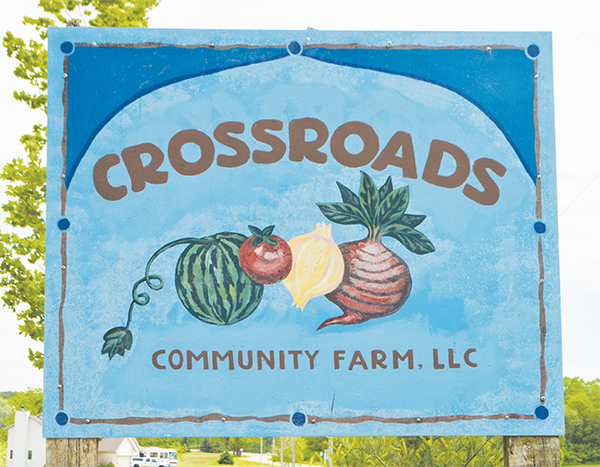 I made a trek out to Wisconsin in June. I’ve been lucky enough to visit this gorgeous state a few times, and I was glad to return. Wisconsin is the state with the second most organic acres in the country, behind California. It’s been an important crucible for the organic ag movement since the beginning. Out of the 177 of Chris Blanchard’s Farmer to Farmer podcasts, 21 featured Wisconsin-based businesses. From that list I chose two farms to visit and interview for this column.
I made a trek out to Wisconsin in June. I’ve been lucky enough to visit this gorgeous state a few times, and I was glad to return. Wisconsin is the state with the second most organic acres in the country, behind California. It’s been an important crucible for the organic ag movement since the beginning. Out of the 177 of Chris Blanchard’s Farmer to Farmer podcasts, 21 featured Wisconsin-based businesses. From that list I chose two farms to visit and interview for this column. 
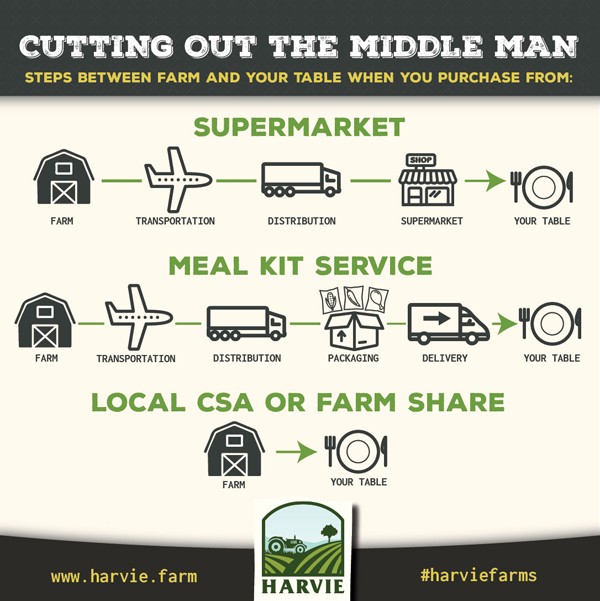 “CSA is dead” is a refrain I have heard from multiple farms in the past few years. I started to hear rumblings of a problem with the CSA model in 2014 through the CSA Farmer Discussion group that I manage on Facebook which brings together over 2,500 CSA farmers from all over the world. Farmers reported that they were having trouble attracting and retaining membership.
“CSA is dead” is a refrain I have heard from multiple farms in the past few years. I started to hear rumblings of a problem with the CSA model in 2014 through the CSA Farmer Discussion group that I manage on Facebook which brings together over 2,500 CSA farmers from all over the world. Farmers reported that they were having trouble attracting and retaining membership..jpg)
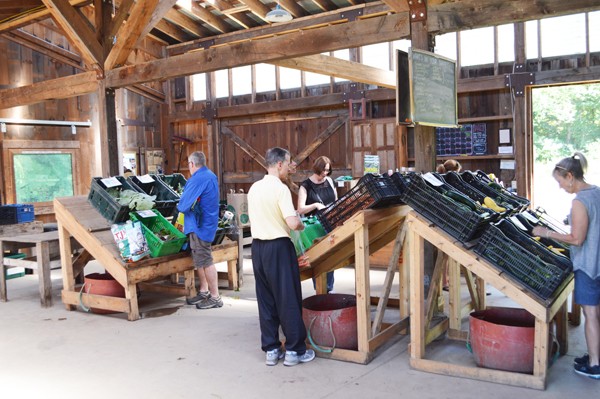 It’s an incredibly cool, clear and dry July day in Massachusetts as I make my way to Brookfield Farm. Dan has arranged for me to visit at 2PM on a Thursday so I can see this bustling CSA farm at distribution time. I arrive just before the appointed hour, and see the last details of the setup being handled by apprentice Ellen. Dan and Karen are bustling around the corner, checking that the room is ready for the deluge of customers to come.
It’s an incredibly cool, clear and dry July day in Massachusetts as I make my way to Brookfield Farm. Dan has arranged for me to visit at 2PM on a Thursday so I can see this bustling CSA farm at distribution time. I arrive just before the appointed hour, and see the last details of the setup being handled by apprentice Ellen. Dan and Karen are bustling around the corner, checking that the room is ready for the deluge of customers to come. 
 Getting to High Ground Organics means going through the belly of the beast of California’s agricultural sweet spot – the Central Coast. This is where high value crops are grown right to the property line, right next to towns and suburbs, cheek by jowl. The proximity to the Pacific Ocean mitigates the climate of this region so it’s never that hot and never that cold; they can grow and harvest strawberries from March to October.
Getting to High Ground Organics means going through the belly of the beast of California’s agricultural sweet spot – the Central Coast. This is where high value crops are grown right to the property line, right next to towns and suburbs, cheek by jowl. The proximity to the Pacific Ocean mitigates the climate of this region so it’s never that hot and never that cold; they can grow and harvest strawberries from March to October. 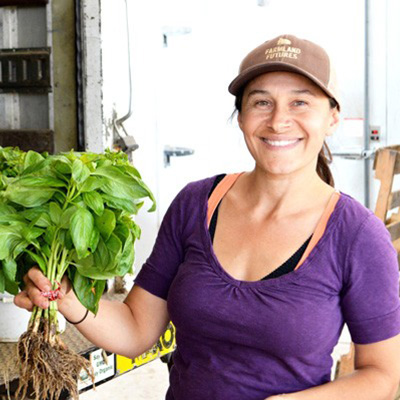
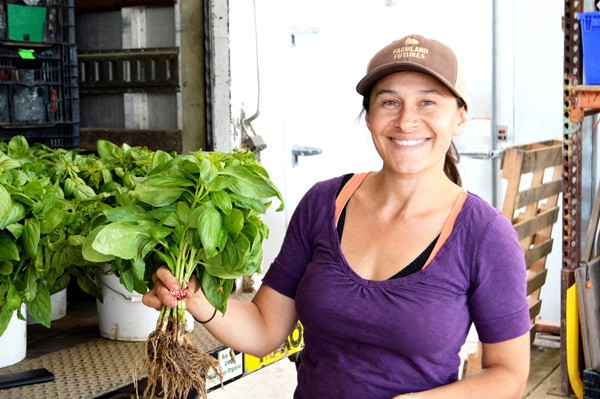 Fifth Crow Farm lies nestled below some ragged hills – the native grass fully brown, the oaks wide and green. The farm grows 50 acres of certified organic crops on 150 acres of leased land, including vegetables, cut flowers, dry beans and eggs. The farm land is completely flat, tucked in a tiny valley in zone 9B. Believe it or not, just across the street, a mere two miles from the ocean, there are acres and acres of open land with cows grazing. How can land so close to such beauty, and with such a wonderful growing season be devoid of development? The answer is complicated, but mostly it’s because the parcels of land have always been quite large, and much of it is being purchased for conservation purposes.
Fifth Crow Farm lies nestled below some ragged hills – the native grass fully brown, the oaks wide and green. The farm grows 50 acres of certified organic crops on 150 acres of leased land, including vegetables, cut flowers, dry beans and eggs. The farm land is completely flat, tucked in a tiny valley in zone 9B. Believe it or not, just across the street, a mere two miles from the ocean, there are acres and acres of open land with cows grazing. How can land so close to such beauty, and with such a wonderful growing season be devoid of development? The answer is complicated, but mostly it’s because the parcels of land have always been quite large, and much of it is being purchased for conservation purposes.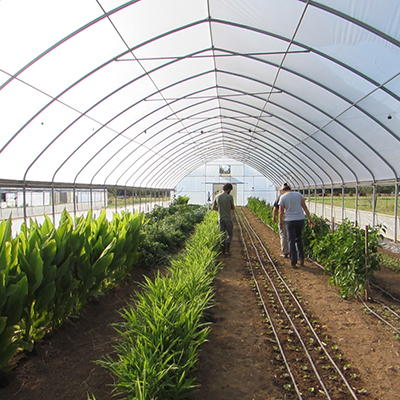
 For years, my wife and I have been considering offering a winter CSA, but have been hesitant. This hesitation stemmed mostly from not having any real experience growing over winter (beyond the kale and collards that persist until January in our fields), but also from lacking the proper infrastructure. This year, however, with two small tunnels up and some decent storage facilities, we decided to make the leap. But I first wanted to talk to a few winter growers to see how they run their winter CSAs to get some pointers on what to expect, what to plan for, and how to manage everything from the hoophouse to the wash/pack. Here is what I learned.
For years, my wife and I have been considering offering a winter CSA, but have been hesitant. This hesitation stemmed mostly from not having any real experience growing over winter (beyond the kale and collards that persist until January in our fields), but also from lacking the proper infrastructure. This year, however, with two small tunnels up and some decent storage facilities, we decided to make the leap. But I first wanted to talk to a few winter growers to see how they run their winter CSAs to get some pointers on what to expect, what to plan for, and how to manage everything from the hoophouse to the wash/pack. Here is what I learned.